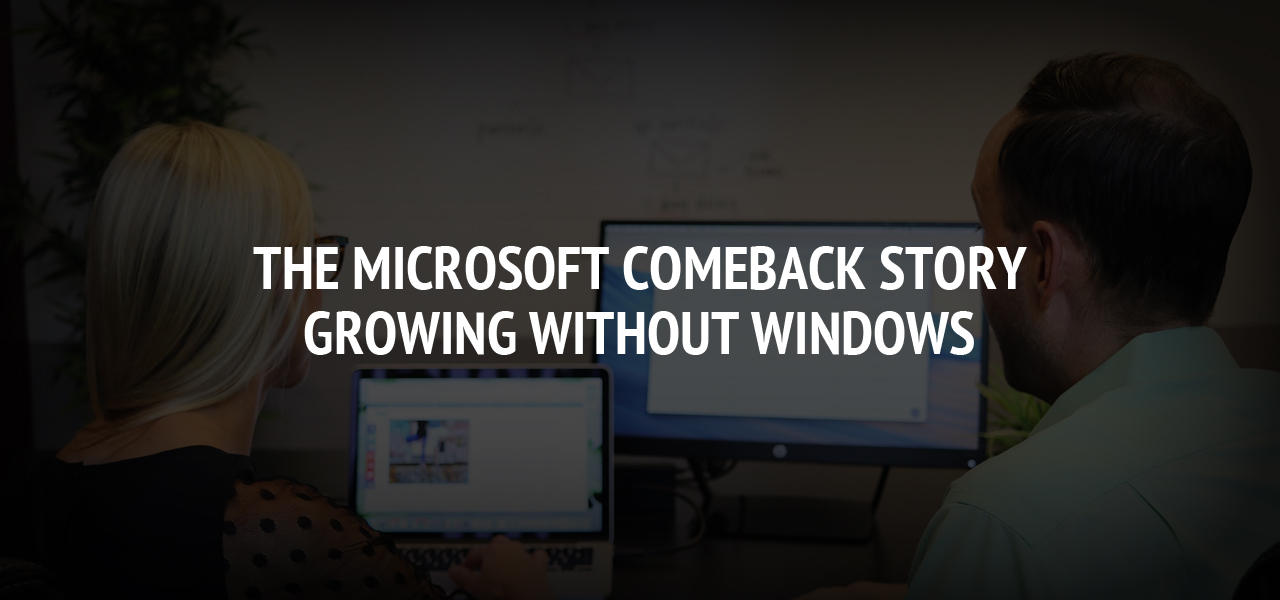The Microsoft comeback story: Growing without Windows

Though it was short-lived, many people were amazed by Bill Gates hitting the ‘World’s Richest Man’ title once again post his philanthropy initiatives after stepping down as the CEO of Microsoft. The depleting Windows PC operating system business and $2 billion loans to Dell, like the Nokia bailout, created a buzz in the valley. This series of incidents have sparked curiosity amongst the people in Tech, Finance, and even the common folk regarding the economic stronghold of the giant. Let us dissect the comeback story without Windows and see what the community can learn from it.
So What is the Current Financial Strength of Microsoft and the Overall Horizon of Computer OS Business
On 11th of November, 2019; the stock prices of MSFT closed at an all-time high of 146.11, and it has emerged as one of the best stocks for investors. The $1 Trillion worth is another feather in the cap for the tech corporation. Currently, they are pushing their OS ecosystems to be omnipresent, with Windows 10X being the latest addition to their lineup. Surface Neo was a much-anticipated move, and all of these innovations revolve around Windows Core OS with built-up additions. Shared technologies will expand the reach of the OS to diverse platforms like gaming (Xbox) and HoloLens for a seamless user experience.
Also, the Composable Shell (CShell) program oriented for a fluidic transition from desktop mode to tablet mode is advancing rapidly. We can expect the trend as a healthy one for the business as it taps both retail consumers to big corporations. However, it is to be noted that these are not the core revenue streams anymore. Dive in deeper to understand new strategies that drive growth.
Acquisitions and Emergence as a Leader in the Cloud World
The high voltage acquisition streak has sharpened with the latest buyout of the open-source software platform Github valued at $7.5 Billion. Taking over LinkedIn ($28.1 Billion/2016) and Skype ($8.5 Billion/2011) are the most substantial deals so far placed exactly above Github. But, the Nokia venture ended miserably like aQuantive ad films. Overall, they have been aggressively expanding horizons apart from non-traditional businesses.
The Smartphone Race: Bill’s Take on the Subject
Gates has acknowledged that loosing to Android has been his biggest mistake so far. Current CEO Nadella also affirmed the same by shunning Windows for Smartphones while stating that being a third competitor with negligible market share to attract developers isn’t feasible. Contemporary genesis depicts a probable return to the smartphone OS segment, but it remains mere speculation so far.
The need to move over-the-cloud is not limited to the operating systems as most of the software like CRM modules, payroll software, data storage, and ERP solutions are migrating to it because of the techno-economic changes. Staying connected to the internet is an essential part of surviving in the economy. Packaged Software solutions are losing ground, and low personal computer sales are equally alarming situations for Microsoft due to the dawn of smartphones and internet connectivity.
So What is the Reason Behind this Drift
“Diversification is protection against ignorance. It makes little sense if you know what you are doing.”
- Warren Buffet.
Like all commercial pursuits, even the most profitable products will turn irrelevant, and diversification will act as the sole insurance. Recently, a surge in the cloud technologies has been witnessed in the global market, and the Microsoft corporation has stepped forward in harnessing this opportunity. The cloud-centric business model is bringing in two-third of the total revenue, and its recurring nature is also commendable for the financial health of the company.
The model used previously was extremely bankable in past conditions, but the developing circumstances demanded an entirely new approach. This could be only possible with a strong leader at the top who’d eliminate all bottlenecks once and for all.
Satya Nadella: The change of face who went on to become the face of change!
After Satya Nadella was appointed the CEO in 2014, he boldly altered the business model in totality. The impetus to IaaS (Infrastructure as a Service) products like Azure and writedown for Nokia has made a huge impact. Recently, Pentagon awarded Microsoft with a $10 Billion contract for updating its digital infrastructure leaving behind the big fishes like Amazon, IBM, and Oracle. (source: The Guardian)
Changing the internal work culture (Being on the world’s best employer list of Forbes), becoming a vendor friendly company, partnering with competitors like AWS, Apple (Calling iPhone as iPhone Pro because of the installed MS Office Apps - Business Insider) and embracing open source community by shifting some of its software to the Linux. His vision and results that followed are widely applauded within and beyond Silicon Valley.
The Takeaways for the Audience: Understanding the Strategic Outlook
As a thumb rule, the top management shall always remain open to listening to the consumers and middle-level managers. Nokia happens to be the best example of ignoring market dynamics alongside Kodak. Investing in the growing demands regardless of the opposition to current revenue streams is essential to survival in the longer run. Being open to opportunities will always fetch better results. Especially in the tech sector, the most significant competitive edge for any company is to tap the arising demands with an early bird advantage. Staying focused on running companies strategically without succumbing to internal politics or denial to volatile external conditions is exceptionally crucial for staying successful.
Future Ahead
Microsoft's comeback story will remain a favorite hot one for the B-Schools and entrepreneurs, along with the corporates from all domains. Going forward without the Windows, which was its bread and butter since inception, is a bold yet well-calculated move. Having said this, it is equally important to recognize the cons of flirting with stagnancy. From migrating to cloud infrastructure in order to widen the horizon of recurring revenue, it has come a long way to become an iconic brand despite ups and downs in recent decades.
The future looks all sunny as the company is receiving significant support in its initiatives. This is reflected in the reinstated interest of the developer community to post their shift to Google and Facebook. Building omnipresent software ecosystems is seemingly the most effective gameplan, and it is working like a charm for Microsoft to keep the valley's giant in shape.
About The Author
Related Blog
View All-
What Does It Take To Scale an App in a Crowded Marketplace
These days, almost everything has moved online, be it shopping, working, studying, socializing, and even finding a date. And as more entrepreneurs attempt to leverage the thriving digital economy, it becomes even more challenging to start. Creating an app is one ...
-
Brainstorming Wonderful Application Ideas for 2017
Are you planning to make a new mobile application? You might have millions of ideas in your mind, but do you know that which ideas are the best and give you a huge success. We all know that there were some successful application ideas that were a total shot in ...







